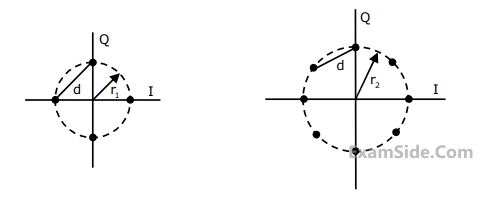1
GATE ECE 2012
MCQ (Single Correct Answer)
+2
-0.6
A BPSK scheme operating over an AWGN channel with noise power spectral density of N02, uses equi-probable signals
$$${s_1}\left( t \right) = \sqrt {{{2E} \over T}\,\sin \left( {{\omega _c}t} \right)} $$$
and $$${s_2}\left( t \right) = - \sqrt {{{2E} \over T}\,\sin \left( {{\omega _c}t} \right)} $$$
and $$${s_2}\left( t \right) = - \sqrt {{{2E} \over T}\,\sin \left( {{\omega _c}t} \right)} $$$
over the symbol interval, $$(0, T)$$. If the local oscillator in a coherent receiver is ahead in phase by 450 with respect to the received signal, the probability of error in the resulting system is
2
GATE ECE 2012
MCQ (Single Correct Answer)
+2
-0.6
A binary symmetric channel (BSC) has a transition probability of 1/8. If the binary transmit symbol X is such that P(X =0) = 9/10, then the probability of error for an optimum receiver will be
3
GATE ECE 2011
MCQ (Single Correct Answer)
+2
-0.6
A four phase and an eight-phase signal constellation are shown in the figure below.


For the constraint that the minimum distance between pairs of signal points be d for both constellations, the radii r1, and r2 of the circles are
4
GATE ECE 2011
MCQ (Single Correct Answer)
+2
-0.6
A four phase and an eight-phase signal constellation are shown in the figure below.


Assuming high SNR and that all signals are equally probable, the additional average transmitted signal energy required by the 8-PSK signal to achieve the same error probability as the 4-PSK signal is
Questions Asked from Noise In Digital Communication (Marks 2)
Number in Brackets after Paper Indicates No. of Questions
GATE ECE 2025 (1)
GATE ECE 2016 Set 1 (2)
GATE ECE 2015 Set 2 (1)
GATE ECE 2015 Set 1 (2)
GATE ECE 2014 Set 4 (2)
GATE ECE 2014 Set 2 (1)
GATE ECE 2013 (1)
GATE ECE 2012 (2)
GATE ECE 2011 (2)
GATE ECE 2010 (2)
GATE ECE 2009 (2)
GATE ECE 2008 (1)
GATE ECE 2007 (5)
GATE ECE 2006 (2)
GATE ECE 2005 (3)
GATE ECE 2004 (1)
GATE ECE 2003 (2)
GATE ECE 2001 (1)
GATE ECE 1999 (2)
GATE ECE 1988 (2)
GATE ECE 1987 (1)
GATE ECE Subjects
Signals and Systems
Representation of Continuous Time Signal Fourier Series Discrete Time Signal Fourier Series Fourier Transform Discrete Time Signal Z Transform Continuous Time Linear Invariant System Transmission of Signal Through Continuous Time LTI Systems Discrete Time Linear Time Invariant Systems Sampling Continuous Time Signal Laplace Transform Discrete Fourier Transform and Fast Fourier Transform Transmission of Signal Through Discrete Time Lti Systems Miscellaneous Fourier Transform
Network Theory
Control Systems
Digital Circuits
General Aptitude
Electronic Devices and VLSI
Analog Circuits
Engineering Mathematics
Microprocessors
Communications
Electromagnetics